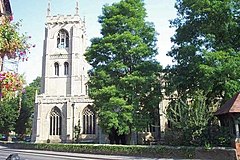Kirton-in-Holland
| Kirton | |
|---|---|
 Church of St Peter and St Paul, Kirton |
|
| Kirton shown within Lincolnshire | |
| Population | 5,371 |
| OS grid reference | TF304385 |
| • London | 100 mi (160 km) S |
| District | |
| Shire county | |
| Region | |
| Country | England |
| Sovereign state | United Kingdom |
| Post town | BOSTON |
| Postcode district | PE20 |
| Dialling code | 01205 |
| Police | Lincolnshire |
| Fire | Lincolnshire |
| Ambulance | East Midlands |
| EU Parliament | East Midlands |
| UK Parliament | |
Kirton, or Kirton in Holland, is a village and civil parish within the Borough of Boston, in Lincolnshire, England. The population of the civil parish at the 2011 census was 5,371.
Kirton was the seat of Lincolnshire's first Saxon kings, later becoming a market town.
In the Domesday account the village is written as “Cherchetune”. It consisted of 52 households, with 30 freemen and 16 smallholders, 12 ploughlands, 10 plough teams, a meadow of 60 acres (0.24 km2), a church and 2 salthouses. In 1066 lordship of the manor was held by Earl Ralph, being transferred to Count Alan of Brittany in 1086.
Hitherto, the parish had formed part of Boston Rural District, in the Parts of Holland. Holland was one of the three divisions (formally known as parts) of the historic county of Lincolnshire. Since the Local Government Act of 1888, Holland had been in most respects a county in itself.
In 1885 Kelly's Directory recorded Kirton as having a station on the Great Northern Railway. This closed in 1961.
There existed Congregational and Wesleyan chapels and almshouses for four poor women. The village market was then disused. The Gas Consumers' Company Ltd was formed here in 1865. Principal landowners were The Mercers' Company, Sir Thomas Whichcote DL, E. R. C. Cust DL, the Very Rev. Arthur Percival Purey-Cust DD, and Samuel Smeeton, whose residence was the "modern white building" of D'Eyncourt Hall. Agricultural production within the 8,962 acres (36.27 km2) parish consisted of wheat, beans and potatoes, and there was a "large quantity of pasture land" and 676 acres (2.74 km2) of marsh land. The 1881 the ecclesiastical parish population was 2,011, the civil parish, 2,580.
...
Wikipedia

